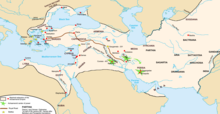Makran
From Wikipedia, the free encyclopedia
The present day Makran (Urdu: مکران) is a semi-desert coastal strip in the south of Sindh, Balochistan, in Iran and Pakistan, along the coast of the Arabian Sea and the Gulf of Oman. The present day Makran derived its name from Maka a satrap of Achaemenid Empire.
[edit]Achaemenid era
Maka was an important early eastern satrapy of Cyrus the Great founder of the Achaemenid Empirecorresponding to modern day Bahrain, Qatar, and United Arab Emirates, plus the northern half ofOman and also Balochistan and Sindh province of Pakistan.[1]Cyrus the Great united several ancient Iranian tribes to create an empire.
The word Maka later became Makran as it is common in closely related ancient Avestan and Old Persian languagesto use "an" and "ran" at the end of plurals.[2]. TheBabylonians had also made voyages using Maka to communicate with India.[3] After Cyrus' death Darius I of Persia succeeded his throne. According to Greek historianHerodotus, Darius wanted to know more about Asia. He wished to know where the "Indus (which is the only river save one that produces crocodiles) emptied itself into the sea".[4]. After personally leading his elite forces, whose ranks were restricted to those with Persian, Mede or Elamite ancestry, to fight the invading Scythians, he lead another conquest towards Indian sub-continent.[5][6][7] where he conquered Sindh in 519 BC and constituted it as his 20th Satrapy and made use of the ocean there.[8][9]After the fall ofAchaemenid Empire, Alexander also used Maka during his conquest and marched through a harsh desert path in Makran where he lost a significant number of soldiers but did not come across any Baluch force during his conquest except some coastal inhabitants. The harsh desert path is often mistaken as the whole of Makran region. Herodotus on several occasions mentions the contribution of "Mykian" that inhabited the eastern portion of the Achaemenid empire.[10]They are mentioned as "the men from Maka" in daiva inscriptions. The "Daiva inscription" is one of the most important of allAchaemenid inscriptions. They also took part in army of Xerxes the great at the battle of Thermopylae. The Mykians are also thought to be responsible for many inventions like qanats and underground drainage galleries that bring water from an aquifer on the piedmont to the gardens or palm groves on the plains. These inventions were very important reasons behind the success of the empire. The Mykians of the other side of ancient Maka, the present day region of Balochistan and Sindh had later taken independence because they are not mentioned in the book written by Arrian of Nicomedia about campaigns of Alexander the great but he only mentions the Oman side of Maka which he calls "Maketa". The reasons for this may have been the arguably unjust rule of Xerxes.[11][12][13] [14]
[edit]Modern era
The narrow coastal plain rises very rapidly into several mountain ranges. Of the 1,000 km coastline, about 750 km is in Pakistan. The climate is very dry with very little rainfall. Makran is very sparsely inhabited, with much of the population being concentrated in a string of small ports including Chabahar, Gwatar, Jiwani, Gwadar (not to be confused with Gwatar), Pasni, Ormara and many smaller fishing villages.
The coast of Makran possesses only one island, Astola Island, near Pasni, and several insignificant islets. The coastline can be divided into an eastern lagoon coastline and a western embayed coastline. The main lagoons areMiani Hor and Kalamat Hor. The main bays of the embayed coast are Gwadar West Bay and Gwatar Bay. This latter bay shelters a large mangrove forest and the nesting grounds of endangered turtle species.
From the 15th century onward, the area was ruled by theRind (tribe) which was headed by Mir Chakar Rind. In the late 18th century, the Khan of Kalat is said to have granted sanctuary at Gwadar to one of the claimants for the throne of Muscat. When that claimant became Sultan, he kept hold of Gwadar, installing a governor, who eventually led an army to conquer the city of Chabahar some 200 kilometres to the west.
The sultanate held onto the Makran coast throughout the period of British colonial rule, but eventually only Gwadar was left in the hands of the sultan. On the independence of Pakistan, Makran became a district within the province of Balochistan, minus an area of 800 km² around Gwadar. The enclave was finally transferred in 1958 to Pakistani control as part of the district of Makran. The entire region has been subdivided into new smaller districts over the years.
[edit]See also
- Gwadar
- 1945 Balochistan earthquake
- Makran Coastal Highway
- Makran Division
- Sokhta Koh
- State of Makran
- Lyari Town
- Khor Kalmat
[edit]External links
- Nicolini, Beatrice, The Makran-Baluch-African Network in Zanzibar and East Africa during the XIXth Century, African and Asian Studies, Volume 5, Numbers 3-4, 2006 , pp. 347–370(24)
- Al-Hind: Early Medieval India and the Expansion of Islam 7Th-11th
[edit]Notes
- ^ "History of Herodotus by Herodotus - Massachusetts Institute of Technology (MIT)". mit.edu. Retrieved 2010-09-11.
- ^ "Iranians and Turanians in Avesta". Ali A. Jafarey. accessdate=2010-09-10.
- ^ "The history of antiquity". Max Duncker. accessdate=2010-09-10.
- ^ "History of Herodotus by Herodotus - Massachusetts Institute of Technology (MIT)". mit.edu. Retrieved 2010-09-11.
- ^ "Persia". Angelfire.com. accessdate=2010-09-09.
- ^ "Iranian Provinces: Sistan and Baluchistan". Iranchamber.com. accessdate=2010-09-07.
- ^ "Ancient Persia". Ancientpersia.com. accessdate=2010-09-09.
- ^ "Darius the great". mdc.edu. accessdate=2010-09-10.
- ^ "The largest empire in ancient history". axehd.com. accessdate=2010-09-10.
- ^ "Full Text of Herodotus, Book 7,8 and 9". archive.org. accessdate=2010-10-02.
- ^ "The History, by Herodotus (book7)". cadelaide.edu.au. accessdate=2010-09-07.
- ^ "The History, by Herodotus (book7)". cadelaide.edu.au. accessdate=2010-09-07.
- ^ "Maka". livius.org. accessdate=2010-10-1.
- ^ "How Xerxes rule triggered decline of ancient Persia". livius.org. accessdate=2010-10-1.
[edit]External links
- Balochistan and Makran, Pakistan
- 'Music of Makran: traditional fusion from coastal Balochistan' from the British Library Sound Archive
| |||||||||||





No comments:
Post a Comment